Blog Category: Mobile App
Cost of Python App Development – Inhouse v/s Outsourcing
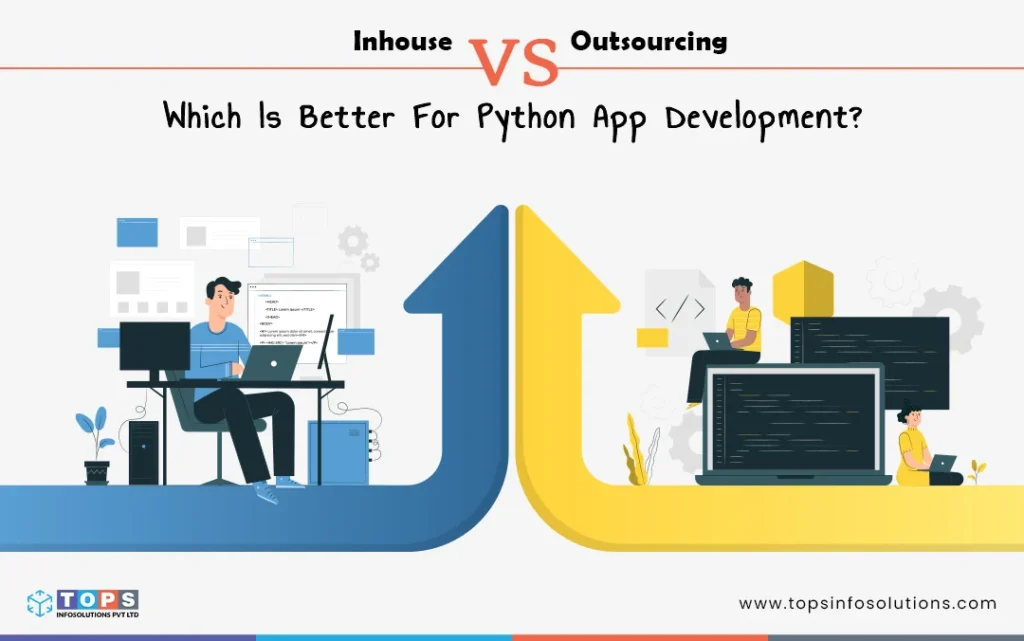
Which one proves best- the homegrown tech capabilities or the software development outsourcing services? Scroll on to the most curious data solving your project puzzles on what creates value from the often overlooked business opportunities.
For many companies, outsourcing IT services is a source of untapped value and savings. Some companies consider it as a ‘noncore’ spend. The case is reversed for companies with the technology innovation capacities and skill sets to address potential opportunities and leverage full value from their in-house development team.
Most importantly, global companies in the dominant industries acquire a great portion of software services from external digital transformation service providers. Annually, the global spending on IT outsourcing services is about $900 billion.
The IT outsourcing market has spiked from $122.9 billion in 2023 to $129.13 billion by the end of 2024 states The Business Research Company.
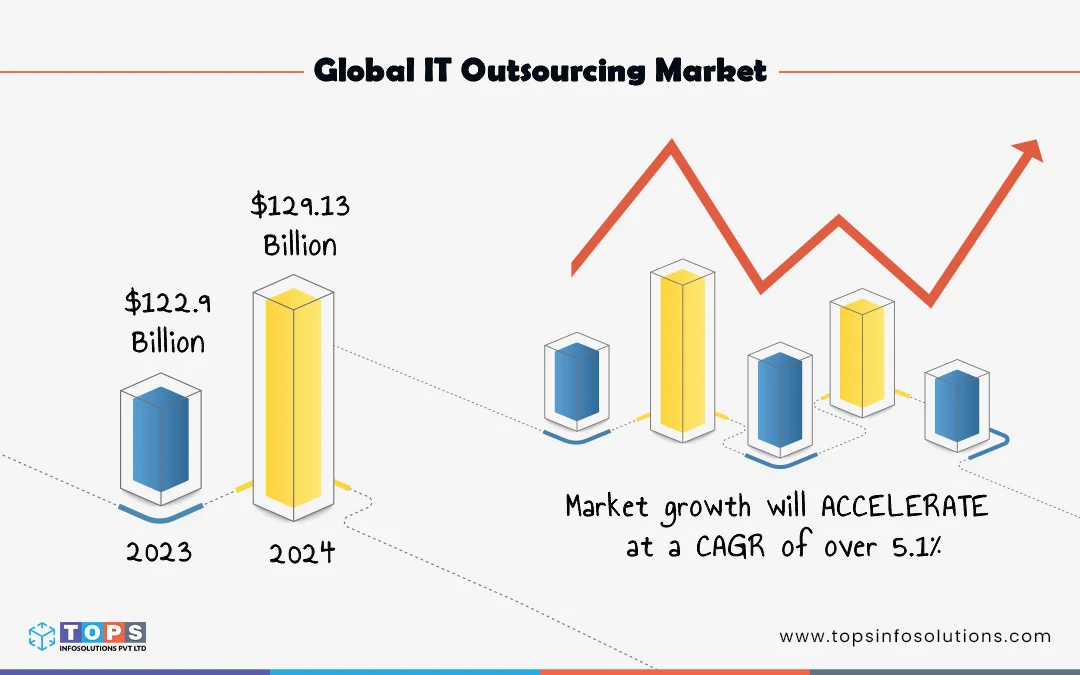
To scale your software development with the right decision and grit, let’s analyze the win-win mechanisms offered by in-house v/s outsourcing Python development services.
We have jotted down all possible advantages and drawbacks of opting for in-house Python development capacity v/s Python development outsourcing services to make a wise business decision on what value it brings to your project.
Comparison of In-house v/s Outsourcing Python App Development Services
Gauge with an in-depth analysis of which option matches your Python app development project needs- a managed IT services provider or a housed staff. Let’s explore which type of app development sourcing positives outweigh the negatives.
| Parameters | In-House Python Development | Outsourcing Python Development |
|---|---|---|
| What Does It Serve? | Hire web developers as per your business demands, adding them to your payroll and considering them as your team responsibility keeping in mind upskilling, retentions, and employee promotion process for each in-house developer. | Join forces with a software development outsourcing partner that takes care of all the technology management of your project, from experts needed, timelines, budget, IT infrastructure, use of the latest tech stack, and faster development lifecycle. |
| Skillset Struggle v/s Access to Global Talent | Every different platform needs specific skill sets. For instance, iOS and Android development demands intricate expertise in coding languages like Objective C or Java. The process of searching for and sourcing the right skill sets proves a challenging task in today’s market where a shortage of skill sets has been a great concern. | You get access to specialized and latest skill sets with all the domain expertise needed for your Python development project like Django development, data analytics, AI experts, or cloud computing experts. With the global talent pool, it’s easy to evolve your project scope and keep up with the latest techniques. |
| Expensive v/s Cost-effective | The cost of hiring in-house Python developers is more than just their salaries. From setting up the development infrastructure and training expenses, to even employee engagement activities, it takes a high financial investment for your Python development solution. | You pay a fixed fee for IT outsourcing services ensuring updated and secure software development by the certified Python developers, project progressing as per the focused timelines and budgets. |
| Cultural Fit v/s Unfamiliar | During the hiring process, recruiters can gauge a candidate’s suitability to fit in the company culture. This makes the candidate easily collaborate with the company’s vision and mission when hired internally. | App development outsourcing partners will need an initial brief about your company vision, processes, and system you use, along with the project blueprint. Initial ideation will help them shortlist the best developers culture-fit for your project. |
| Time Commitment | You require a significant commitment to timelines for your Python web development project. | Python development outsourcing companies have to serve project deadlines as per planned stages of app development lifecycle. |
| Limitations v/s Flexibility | Serves businesses with limited scalability of skill sets as per project needs. When your project scope demands more skill sets at any of the development stages, it proves tricky to hire mobile app developers instantaneously when trying to scale your development team effectively. | erves you the competitive edge with complete scalability of the software development team. If your project needs varied expertise at any development stage, it becomes easier than ever to leverage just-in-time project-ready skill sets from mobile app development outsourcing services providers. |
| Focus on Business Operations | It becomes more stressful when tech issues arise and if you aren’t experienced in technology and have to parallelly handle business operations effectively. For complicated mobile app development projects, in-house sourcing can prove challenging even if you have technical know-how. | Focus on the core of your business operations whilst a dedicated full-stack developer handles all your technology management, be it a simple or complicated web app development project. It ensures your IT infrastructure is updated with productive project progress. |
| Faster Development Lifecycle | Limited skill sets and limited use of the latest development tools lack a faster app development lifecycle. | Use of advanced tech expertise and the latest development tools proves best for a faster and more productive app development lifecycle. |
| Security Concerns | If your project scope expands, it’s not as easy as plugging an additional programmer into your in-house team. Challenges pile up from accountability, lack of specific expertise, and struggle to track the root cause of development issues that leave your project stalled out. | To onboard dedicated Python developers from a trusted app development agency makes the app solutioning immediate, from adding more experts to the team, accountability, use of AI tools for development, and instant tracking of development issues, it helps build your app with high-quality and security across all development phases. |
What’s the Cost of In-house Python App Development?
The cost of Python app development by the in-house team includes multiple parameters to come up with an accurate cost figure. It involves budget calculations for developer’s salaries, HR costs, cost of the development tools, hardware cost for developing a workstation for each developer, and testing devices. Managing an internal software developer and supervising the team takes time and resources.
What’s the Cost of Outsourcing Python App Development?
The cost of Python development services outsourcing depends on the app complexities, unique features, and the location of your mobile app development company. The right formula to calculate the outsourcing cost involves external teams cost and time taken on the development phases.
Which One To Choose Out of the Two- Inhouse or Outsource?
The benefits of both are substantial. However for most software development projects, the perks of IT outsourcing are far-reaching. From cost saving, time commitment, and access to global expertise to gain a competitive edge, it helps SMEs, established businesses, to even large-scale setups thrive with optimized digital transformation.
Explore the checklist to select the right IT outsourcing services provider and discover how TOPS can be your project-ready outsourcing partner.
Don’t Tackle It Alone, Bring A SideKick Along
Access experienced python developers from the comfort of your office. Python development outsourcing service offered by TOPS itself is an essential checklist to select the right outsourcing partner for your app development project.
- We rightsize your IT investments to fit your business needs.
- Ready-to-use software development infrastructure.
- Every project is backed by a project manager and a team of experienced quality analysts ensuring the code quality and minimal to zero errors in the development phases.
- We ensure no overrun of your project spendings.
- Full confidentiality and shared accountability.
- A client-centric approach helps us deliver complete transparency in communication along with end-to-end and prompt development assistance during and after the development phases.
How to integrate Flutter into IOS mobile applications
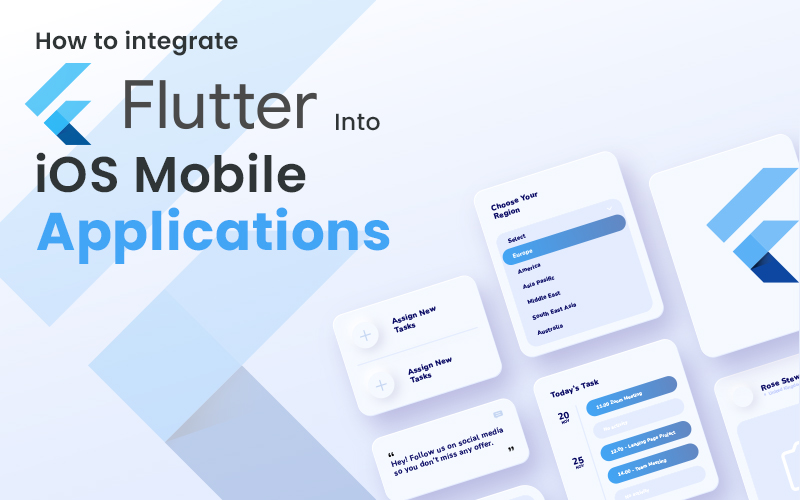
In today’s competitive mobile app market, businesses are constantly looking for ways to improve their iOS applications. Flutter, Google’s open-source UI framework, offers a powerful solution by enabling the integration of Flutter modules into existing iOS mobile applications. By incorporating Flutter’s rich UI capabilities, businesses can enhance their app’s performance, user experience, and development efficiency.
In this blog post, we will guide you through the process of integrating a Flutter module into your existing iOS mobile application, empowering you to take your app to the next level.
1. Assess Your Existing iOS Application:
2. Set Up Flutter Environment:
3. Create the Flutter Module:
4. Configure Flutter Module for iOS Integration:
5. Add Flutter Module as a Dependency:
6. Configure Build Settings:
7. Communicate Between Flutter and iOS:
8. Test and Validate:
9. Deployment and Maintenance:
PDF content from here : starting from
There are a few ways to embed Flutter in your existing application.
Here are some types of applications that can benefit from the integration of Flutter modules:
1. E-commerce Applications

Enhance your e-commerce app with Flutter modules to deliver a visually appealing and interactive shopping experience. Utilize Flutter’s rich UI capabilities to create stunning product displays, intuitive navigation, and seamless checkout processes.
2. Social Networking Applications
Integrate Flutter modules into social networking apps to improve user engagement and create dynamic interfaces. Flutter’s flexibility allows for real-time updates, interactive feeds, and visually appealing user profiles.
3. On-demand Service Applications

Streamline on-demand service apps by integrating Flutter modules. Leverage Flutter’s fast development cycle to create efficient and user-friendly interfaces for services such as food delivery, ride-sharing, home services, and more.
4. Travel and Tourism Applications
Enhance travel and tourism apps with Flutter modules to provide immersive experiences and engaging interfaces. Utilize Flutter’s animation capabilities to showcase travel destinations, incorporate interactive maps, and create visually appealing booking processes.
5. News and Media Applications

Integrate Flutter modules into news and media apps to deliver engaging and visually appealing content. Leverage Flutter’s flexibility to create interactive articles, personalized news feeds, and seamless video streaming.
6. Health and Fitness Applications
Enhance health and fitness apps with Flutter modules to create visually appealing and user-friendly interfaces. Leverage Flutter’s widget library to develop interactive workout routines, track progress, and provide personalized health insights.
7. Educational Applications

Integrate Flutter modules into educational apps to create immersive and interactive learning experiences. Leverage Flutter’s animation capabilities to develop engaging quizzes, interactive lessons, and personalized learning paths.
8. Financial Applications
Improve financial apps with Flutter modules to create visually appealing and intuitive interfaces for banking, budgeting, investment tracking, and more. Flutter’s cross-platform capabilities enable consistent user experiences across different devices.
9. Gaming Applications

Create visually stunning and interactive gaming experiences by integrating Flutter modules into gaming apps. Leverage Flutter’s animation and graphics capabilities to develop engaging gameplay, immersive worlds, and seamless in-app purchases.
10. Productivity Applications
Enhance productivity apps with Flutter modules to create visually appealing and feature-rich interfaces for task management, note-taking, document editing, and collaboration. Flutter’s customizable UI elements enable a tailored user experience.
These are just a few examples of the types of applications that can be built or enhanced by integrating Flutter modules into your existing iOS mobile application. Flutter’s versatility and powerful UI capabilities enable developers to create a wide range of applications across various industries, catering to specific business needs and user requirements.
Conclusion
Integrating Flutter modules into existing iOS applications offers a significant opportunity to enhance your app’s performance, user experience, and development efficiency. By following the step-by-step guide outlined in this blog post, you can seamlessly integrate Flutter modules into your iOS app, leveraging Flutter’s powerful UI capabilities and cross-platform potential. Embrace the power of Flutter to transform your existing iOS application into a visually stunning and feature-rich product, enabling your business to thrive in the competitive mobile app landscape. Do you have an application similar ? Please get in touch with us.
7 Latest iOS App Development Trends You Should Know About
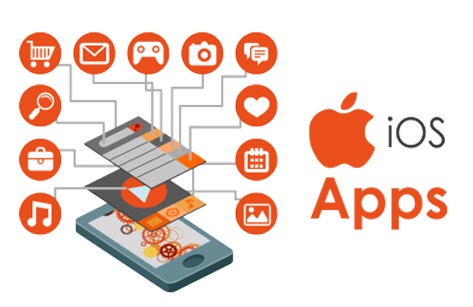
If you are a mobile software business owner and want to stay on top of the market competition, it is time for you to comply with the industry demands and create efficient and user-friendly apps. While Android app development can come across as a measure to capture a large share of the market, iOS app development is the most efficient way to monetize your application. So what should be your next step? Hire an iOS programmer! But before we discuss that, you must first understand the technology that goes behind iOS app development.
Which Technology is Used for App Development?
If you are a developer and are reading this, you must understand that as dynamic as the mobile software industry is – it demands technology that is quick-evolving too. Several technologies are used for iOS app development with the top six being XCode, AppCode, CodeRunner, Flutter, BuildFire, and AppiePie.
If you are a business owner and are looking to hire a freelance iOS developer, you know that you are looking for a candidate who is proficient in these technologies.
So what should you be looking for when you are hiring dedicated iOS app developers? Professionals who are aware of the following iOS App Development trends which are the future!
iOS App Development Trends That Are the Future!
Machine Learning and Artificial Intelligence
Machine Learning and Artificial Intelligence are the future. They are now a part of our daily lives more than ever! If you are looking to hire a dedicated iOS app developer for your business, your candidate should be aware of trends such as speech recognition, renewed algorithms of Siri, accurate analysis of online behavior of the user, optimizing search processes, and integrating them into the app.
-
Internet of Things
From logistics to the agriculture sector, IoT has revolutionized the lives of internet users. For iOS app developers, it is critical to integrate IoT as there are already applications that can help in identifying heart diseases, facilitate remote control of home theatres and even water supply in homes, and control farms and plantings directly from a tablet or phone. The future is of those who can top these inventions and use IoT to deliver new-generation conveniences.
-
Augment Reality and the ARKit
Snapchat and Pokemon Go are apps that have made the augmented reality even more desirable. Apple offers the ARKit 3 that offers augmented reality experiences to its users. These apps consume a lot of energy and hence are compatible only with the latest devices by Apple. Going forward, it is expected that apps that offer apps that expand the capabilities of the device, provide the improved illusion, and facilitate sharing of experience will be in demand. This is a trend that new-age developers need to be aware of and be ready in terms of skills. If you are looking to hire dedicated iOS developers, this is a factor that you should bear in mind.
- ApplePay
For the iOS platform, the Apple Pay trend is something that iOS developers will have to be mindful of. Currently, the strengths of this technology include the freedom of usage anywhere, high security, and 24/7 availability even when the user is not carrying their card with them. If you are hiring a freelance iOS App Developer, look for an enterprising individual who can create or improvise on the ApplePay trend.
- Cloud Integrated iOS Apps
Apple introduced iCloud in 2011 and there have been multiple upgrades to it since then which have improved its utility and functionality. In the future, app developers have to look at upgrades that allow cheaper development that brings about a price drop. Furthermore, scalability and safety upgrades are features that are expected out of Apple’s Cloud Integration trend.
-
iBeacon
iBeacon is a new trend in mobile application development that is changing the game in the marketing space. This iBeacon app is expected to bring out a revolution in sales strategies and is especially beneficial for the art sector.
-
ChatBot
Chatbots are not a new application but their functionality is evolving with time. The expected outcomes from the ChatBot trend is that it will increase throughput by expanding reach among customers, self-service for customers, and providing 24/7 availability.
Wondering where you can find skilled and enterprising iOS app developers? Reach out to Tops Infosolutions today!
Hire the Best iOS Developers Online!
TOPSInfosolutions offers you expert and experienced iOS developers who are equipped with the latest tools and techniques to address specific business requirements. To know more about hiring an iOS programmer online, you can reach out to us by writing to contact@topsinfosolutions.com or calling us at +1 408 400 3737 or +91 7575 000 269.
iOS App Development: A Domineering Force in Mobile Consumer Market
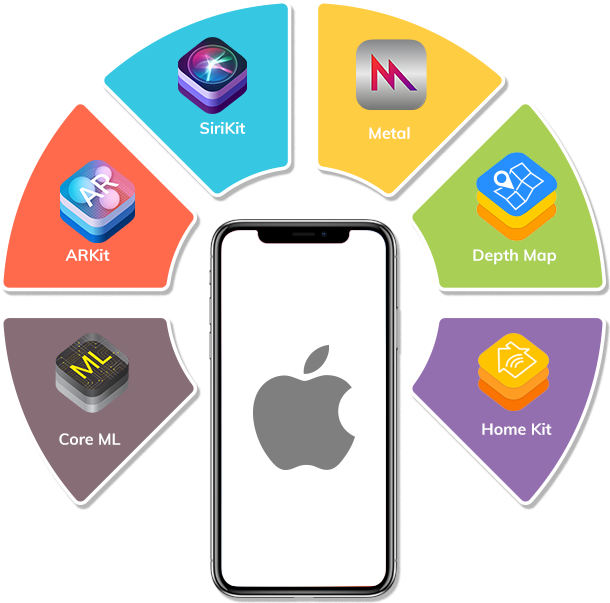
Currently, the iPhone app development is very much profitable in the market today. It has become difficult to imagine a life without apps for doing almost everything from shopping, dining, cooking, traveling, exercising, banking, and many more. But one should make the right app with the proper functionality, support, and rollout to be successful.
What is iOS app development?
iOS is Apple’s Operating System for any Apple-make hardware like iPhone, iPod Touch, iPad, etc. So, building an app that functions in the iOS platform is referred to as iOS app development. There are several types of apps existing for the iOS platform, including social media apps, games, selfie/touchup apps, messaging/chat apps, etc.
iOS app development market
Companies recognize the need for mobile applications to venture newer heights in revenue and consumer reach for their business. You can employ resources for getting your mobile app developed, or you can hire iOS app developers from a third-party mobile app development company for development solutions. You can also fast-track iOS App Development and go for Android application development, depending on your target audience and market.
Selecting the platform is essential for getting a mobile app developed. It can be either Android or iOS platform or both, depending on the scale of the target audience. Even though it is evident that Android users are more when compared to iOS users worldwide, iOS app introductions and downloads are still on the rise. Considering Apple’s highest market share to be 52.28% in North America, 57.22% in the USA, and 51.4% in the UK, iOS Application Development is an unavoidable choice. Your business can attain the required boost through an iOS app launch in the technology market, particularly in the developed countries.
Almost over 5 million apps are accessible for download in the Apple app store. On average, about 1,082 apps are released regularly and awaiting positive reactions from users. It is all about offering functionality that is alluring, stress-free usage, and most importantly, fulfilling some needs of the customers. If you get those aspects right, your app is a sure shot success in the market, and it slowly gains traction for transforming into the most popular choice of app download in the market.
Why iOS is a Popular Platform?
It is a proven fact that iOS offers a seamless user experience to users. Nevertheless, the iOS Developer Community is also supporting its platform. Almost a massive 64% of developers are present in the community dedicated to iOS resources in the market. It infers that iOS app development is the popular choice in the web and mobile app development market. With a vast pool of resources present, you can choose and settle on the type of resources you require for your iOS App Development Services. The expertise, budget, scope, and time is taken for development are certain factors to be considered for your project.
What languages are used to create iOS apps?
Several native languages are out there that can be applied for developing the iOS application, including Objective-C, Swift, React Native, or Xamarin. The last two languages are cross-platform native languages. Xcode platform has to be used to build iOS apps on the next version currently available on beta release. Xcode 4 also supports C++. Even OCaml can be made use of for developing iOS applications.
Is it easy to develop iOS apps?
Xcode is Apple’s IDE (Integrated Development Environment) for both iOS and Mac applications. It is free to open source and can be downloaded from Apple’s site. It is simple and easier to work with. So, for a novice developer to begin iOS development, this is a good place, to begin with. In addition to this, the iOS Developer Community is whole and supportive, with plenty of freely available knowledge shared among resources.
Final thoughts
The market will forever be bustling with iOS app development solutions. Businesses are always on the lookout for ways, especially during this COVID pandemic, to expand their user base by offering customers a seamless app experience for making purchases that are reliable, secure, and hassle-free. Demand for iPhone developers is on the rise, and companies have constantly been seeking developers who can quickly figure out the latest iOS app development trends and their usage.
If you are looking to outsource your mobile app development solutions, we are a mobile app development company in the USA. We are a high-capacity, customer-centric, passion-driven IT company renowned for delivering impeccable app solutions globally.
Talk with our experts today about your new venture and get a free quote within 24 hours.
Reasons to Consider AWS for Your Next Mobile App Development Project

The benefits of what the cloud can offer are wide-ranged. It is also witnessing a more significant usage for cloud-based app development as it offers good scalability and robustness. Recently, several companies of varying sizes are being taken on the AWS mobile app who are looking to create an agile development environment.
Cloud Benefits for AWS mobile app development
- Economical approach – The app maintenance cost without using a cloud-based app development process can fall more or less anywhere in between $4000 to a whopping $25,000. The on-premise mobile app development progressions take up many resources that can be alternatively utilized for scaling your business.
- Multiple Cloud benefits – AWS provides several cloud benefits for AWS mobile app development. It includes database storage, computing power, content delivery, and other functionalities.
- Increase Productivity – By creating an agile, mobile app development process, their development teams’ productivity levels can be improved and prepared for easy scaling.
AWS for Mobile App development
Here are a few AWS services apt for your next AWS Mobile App development projects and can make it more efficient.
- AWS DynamoDB – It is an entirely-managed cloud service for AWS mobile app development. It provides faster and calculated performance to help achieve the highest scalability. AWS developers can store and retrieve massive volumes of data without any delay or latency.
- Amazon Pinpoint – It helps developers and app marketers efficiently run targeted campaigns and measure performances. From alerts on various promotions to customer retention campaigns, Amazon Pinpoint will offer valuable insights on user engagements with the app.
- AWS Device Farm – It is an application testing service that helps with Android, iOS, and web apps testing and interaction across various devices at the same time. Automated testing helps developers quickly identify roadmaps and integrate user feedback successfully in the mobile app development process.
- AWS Cognito – It allows you to build unique and secure sign-up, sign-in, authentication of the app, access control, and security and compliance requirements for mobile and web users. AWS Cognito keeps a user directory that stores data from millions of users.
- AWS Lambda – Another feature, AWS Lambda, runs code without handling or provisioning the servers. So taking any specific moment, you pay only for the actual computing time used and not when your code is idle. Once the codes are uploaded, AWS Lambda performs the rest. It also helps in code scaling without handling servers for maximum availability.
Why choose AWS mobile app development?
Many companies still operate with an on-premise mobile app development process. However, various industries worldwide shift to the cloud; cloud-based app development is picking up very fast. Here are some of the reasons why quickly growing companies are taking on AWS mobile app development for their products and services.
- Development language – On-premise applications are based on traditional programming languages such as C, C++, C#, Visual Studio, etc. In contrast, cloud-based app development uses web-centric languages like HTML, javascript, Python, Ruby, etc., for their mobile app development process.
- Multitenancy – There are limitations while using an on-premise mobile app development process in a virtual environment as it needs non-virtual space for development. But AWS mobile apps work well in the virtual space and can share resources with other apps too. It helps to keep the process flow and budgets optimized continuously.
- Dynamic scalability – When there is a spike in usage, the cloud-oriented app development process can extend the resources and let go of when the demand normalizes. This provides the AWS certified developers a scalable environment dynamically, not a possible on-premise mobile app development process.
- Traditional vs. modern design – AWS mobile app development design allows functions to be broken into microservices. When not required, it can shut down certain services, and it can do updates to specific modules without hindering the overall performance of the app. The on-premise development is based on a monolithic design, which lacks this flexibility for a developer or a growing company.
- Network and storage – AWS mobile app development offer flexible network and storage connections. This feature helps the developers by offering them a responsive and dynamic environment.
Final thoughts
AWS mobile app development has countless benefits and the fact that cloud-based mobile app development is becoming more trusted for even mobile app development. However, to get started, you need to understand the cloud-based services elaborately. Here is where a mobile app development company proficient in advanced AWS consulting services comes into the picture.
We are a leading mobile app development company in the USA, and our experts can help you get started with anything AWS. You can also hire AWS Certified Developers for your mobile app development, setting up cloud-based app development solutions, or even cloud migration of your existing app. You can also Hire Get in touch with us to know more.
How Can Mobile App Deep Linking Benefit Your Mobile App Development?

The Mobile App ecosystem is a vast and extending network filled with different apps for all needs. Numerous apps are being developed and published on the app store and play store every day.
However, only a few get to the top position based on how useful and easy functionality could be. Mobile app development is an easy task only when each step of the development cycle is analyzed and appropriately framed to be successful.
Every minute step is essential for Mobile app development, and cutting corners may significantly impact the final product sustainability. Here, we’ll see the importance of mobile app deep linking and the essential steps that are not missed during app development.
Mobile App Deep Linking is a URI, uniform resource identifier. It connects to a particular page or the locations inside a mobile application. The primary purpose of deep linking is to offer related information requested to the user through e-mail, push notifications, social media, SMS, etc.
It fundamentally improves the user retention ratio and drives user engagement. In the absence of deep links, URLs will direct the users to the home screen alone and not to the particular content. It will leave the user hanging on the irrelevant page and eventually make them lose interest or rebound.
But, Deep linking has altered mobile apps’ interaction aspect and effortlessly bridges the gap between apps and websites.
Mobile App Deep Linking Models

- Traditional deep linking: Directs users to a particular screen in your mobile app by utilizing your app’s URL. It works only when your app is installed on your mobile device; else, it will throw an error page.
- Deferred deep linking: No app installation is needed on the user’s phone. The user clicks the link, and it directs them to the app store, prompting them to download it. Once the download is completed, the user can view the content intended.
- Contextual deep linking: The user is directed to the specific content location. It even stores contextual information such as the link shared by whom, the source from where it’s shared, the location where the users wish to navigate, etc. This data offers a personalized experience to the users by giving them appropriate content, depending on their preferences.
Benefits of Mobile App Deep Linking

- Drives Re-engagement – Scenarios where the users have installed the app but remain inactive for a long time, can be rectified by push notifications. Special deals or relevant content can be promoted to regain the customers’ interest and even turn them into active users.
- Improves App Discoverability – In instances where your website is reeling in visitors, but your mobile app isn’t, then deep linking is the go-to option. You can go for a mobile app with deep linking installed, particularly for searches. It will enable your app to be displayed on the Google search page, thereby making it easier for users to find your app.
- Increases App Downloads – With mobile app deep links, the content gets displayed on the search result page like your website. This link will direct users to install your app, drive more installations for your mobile app, and engage users in the existing platform.
- Link Two Apps – deep linking makes it easy to set up a connection between two apps. If two or more e-commerce apps with various products, the user can be directed to your other app or vice-versa once they are done with what the current app has t offer. Linking apps help to increase the customer base, and revenue generation and also aid in cross-selling products.
- Convenient Content Promotion – Deep links help to build links on the websites, social media platforms, and emails to direct to specific content in the mobile app. It helps in promotion by linking back to your deal or new launches that you wish your customers to see. So, instead of asking users to log in to your app, you can directly link them to your promotional content.
Some of the top brands that harness the power of deep linking are Zomato, Google maps, Ola, Uber, and many more. There are other important tasks involved while creating a mobile application that should not be neglected during the mobile app development process.
1. Market Research
The necessary groundwork for mobile app development is crucial. Research should be done about the target market, competitor analysis, and target audience before commencing the development process. Analyzing whether your idea fits well for the users in the current market trends needs to be determined.
If it is an already existing idea, your unique things must be given much attention to attract consistent active users. Also, define your budget and perform a detailed survey in the beginning stages to smooth the development process.
2. Wire Framing
Preparing a detailed scope of the work, developing a wireframe of your app, and drawing detailed sketches of the product are necessary. It can help check the usability issues
and make sure that the mobile app development process meets your requirements. It can be useful to take feedback from industry experts and rectify any loopholes at this stage so that changes can be incorporated easily.
3. Technical Feasibility Assessment
Checking whether the backend systems support the app functionality is important by accessing public APIs. Moreover, based on different platforms like iOS, Android, etc. there may be varied requirements. So, the technical limitations need to be analyzed during a technical feasibility assessment.
4. UI/UX
Delivering a great user experience is what all boils down to grabbing user attention. Varieties of layout design, navigation buttons, colors, graphics, fonts, styling, and other visual elements can be tried and tested.
It should be aesthetically pleasing and must include functionality, design concepts, timeline, budget, etc., for creating an engaging user interface. To have a first-hand picture of your app, it is best to develop static mockups.
5. App Development Testing
Testing the app for bugs, and incorporating features that are necessary and compatible with powerful smartphones is essential. The app is tested for compatibility, usability, interface checks, stress, security, and performance to ensure that users are happy with the interface.
6. Deployment & Maintenance
Here is where your app gets launched! App store standards and security requirements must be met to publish the app. After release on the App stores, regular updates and maintenance must be done.
Conclusion
Mobile app deep linking is beneficial in revenue generation and offers a superior user experience. When done correctly, it can increase the profitability of your mobile app.
For mobile app development services and custom app development, reach us for more information.
Ways AI can revolutionize the Mobile App Development


AI or Artificial Intelligence offers machines the ability to do what living beings can do. It includes the machines to self-train, and learn new things like humans – seeing, listening, conversing, and studying others. Today’s smartphones and tablets have more sensors compared to other computing devices. Although they can sense temperature changes, ground leveling, and even calculate the device’s real-time speed, it is not enough for AI.
AI capabilities require humongous processing power to execute Natural language understanding (NLU) or intelligent routing in the content delivery system. That is why these battery-operated devices are connected to the internet and cloud computing all the time.
AI in Mobile App Development and NLU
A mobile app is an accumulation of services from multiple third-party API service providers within a native software package, which helps fetch relevant data based on a user’s requests. Likewise, AI capabilities can be added, especially the Natural language understanding (NLU) feature. For Android and iOS mobile devices, Google Actions and SiriKit integrations are predominant. It can bring many AI capabilities into our daily apps, whether it is food or ride.
Delivering Personalized Experience with AI
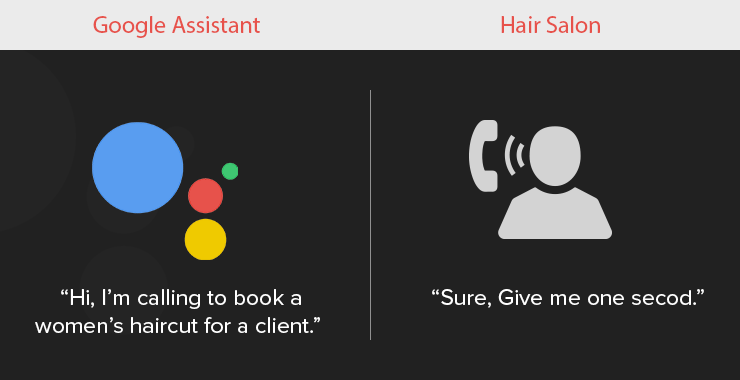

A user’s intent is expressed in two ways: text and speech. Apart from the direct instructions, your routine behavior can be studied ad prompted. Say, you order lunch at a particular time. AI program can self-train and predicting your behavior at the stipulated time. The OS suggests various apps at multiple points of time. Besides suggesting, what if your smartphone notifies on discounts at your regular restaurant or other restaurants serving the food of your choice plus various offers? This extra step is offering a personalized experience to the user.
It is the personal experience that we expect from the apps we use.
Significant Benefits of Mobile App Development with AI



All businesses are thriving on Innovation. It helps the businesses to leverage the added advantage in going for mobile app development for its customers. Some famous brands like Zara, Domino’s Pizza, and Starbucks have proved that mobile app development can boost sales significantly. Let’s see what it has to offer.
-
Inculcates Brand Loyalty
To retain customers, businesses need a compelling mobile app presence. As more potential customers are in the mobile space than PC, unique mobile app developments can alone target brands to its customers. By leveraging AI, brands can set a solid foundation for their customer base.
-
Forms Brand Recognition
Winning the trust of your target audience can only drive customers to commit to your brand. Mobile app development will offer the opportunity to show your users why they should trust in your brand. User-friendly mobile app development with AI intuitive features can make the customers get involved with your app. It also helps to recall your business.
-
Link with on-the-go customers
People are always on the go; work, gym, café, you name it. Their easy access during such times is their smartphones. Nowadays, most people mobile active, and this provides a great opportunity if your brand has a mobile presence—a chance to convert your mobile app visitors into loyal customers irrespective of the location.
-
Craft Personalized content
Mobile apps can establish an emotional bond between the business and its customers through personalization. Studying customer persona, behavior, preferences, and such, you can give personalized content and show that you care. AI plays a vital role, and with tailored content, your chances to meet the specific requirements of the audience and turn them into frequent users are highly possible.
-
Boosts Gains
An increase in customer satisfaction increases sales. The happy your customers are, the more are the chances of visitors and visits to your app and make a purchase. It results in severe returns if you unveil a mobile app in addition to your website.
AI is altering the way we connect with apps. The AI engine is capable of delivering the entire flow from action to fulfillment based on the user’s ‘intent.’ It will communicate with the apps, servers, payment gateways, etc. In this current COVID-19 scenario, mobile apps with AI technology are monitoring vital health statistics to determine any ailment in its initial phase and avoid complications. Well, the future holds so much more.
For AI mobile application development services – Request for call back or a free quote
What to Consider? Freelance Developer or Hiring From Mobile Application Development Company


Nowadays, the mobile app development sector is quite saturated as there several mobile app developers available. Despite the volume, the well-qualified professional who can build the app you need may be considerably less. Finding the best developer to build the right app for your business is challenging. There’s a difference between putting together a fully-functional app and creating an eCommerce app or enterprise mobility solutions. These latter are more complex, and it is best to go by a developer with hands-on experience in that space.
So here’s a list of essential things to look for in mobile application development.
-
Check Platform Availability
The type of mobile app and its chosen platform like iOS, Android, or both is important. Different operating systems have separate coding languages. So, ideally, finding the right developer for individual or both iOS and Android platforms could save you from any developmental issues. A developer or mobile application development company with a hybrid mobile apps creation experience can considerably reduce the cost and time taken. Anyhow, your app eventually needs to be on both platforms. So, it’s better to look for a mobile app developer who can build both.
-
Check Developer Availability
Finding the finest mobile app developer and his availability is an essential factor. Communication is crucial to avoid problems like language barriers and planning phone calls. A freelancer might be an excellent option to reduce the cost, but they probably have multiple projects to work on concurrently. So all efforts won’t be exclusively on your app. Whereas, a mobile application development company will have a team of developers who will be working on your app in unanimity. It makes the app development faster and efficient.
-
Technology Requirements
Technical knowledge is essential. Gathering all the requirements for your application to function correctly is a must. For instance, there is a need for the database server, analytics server, authentication server, or a push notification server. So it is best to explain the features and get a transparent quote.
-
Security features
It goes without saying as a top priority for building an application. Make sure that your developer provides high-level security features like access restrictions, payment gateway security, and many more.
-
Post-Development Support
Regular maintenance is essential. The more the app gets to be used, the more you will know of any minor glitches present. Then the modifications can be made with updates. There are charges incurred per update, either hourly or depending on the resources allocated.
Work with a mobile application development company is much more comfortable in terms of:
- Making simple changes without any self-coding
- Post-development maintenance facility
- Shorter turn-around time by allocating more resources if required
- More availability and better post-launch support.
Although it might be expensive, it saves you a lot more and ultimately gets your app up and running in the market sooner.
We offer services like mobile and web application development in the USA. For custom application development and enterprise mobility solutions, contact us: +1 408-400-3737
Why You Should Build Your Social Networking App in React?


Developers at Facebook created ReactJS, a JavaScript library. Facebook grew too big too fast and soon it was too big for its boots. By early 2012, its user base was already approaching 1 billion users, more than any website ever in the history of the web, and its developers faced problems never encountered before in the history of web development.
At that time, PHP was the mother tongue of web applications and Facebook had already pushed it to its limits. As we know, “Necessity is the mother of all inventions”, the developers at Facebook created React and inspired many similar applications to follow the same path. Around the time Node.js came around and JavaScript replaced PHP as the mother tongue of web development.
While AngularJS was around a while before Facebook came up with React, it was too much similar to MVC web frameworks of those days, more like JavaScript (on Rails). AngularJS was too HTML-centric, and front-end development relied too much on templates. Templates have always been synonymous with dynamic web development.
An Era of Single Page Applications (SPAs)
However, that was an era of single page applications (SPAs), a type of web application that loads a single HTML page and dynamically update that page as the user interacts with the app(read mobile apps on your browser). While SPAs look very convincing on paper, their development isn’t cakes and chocolates for web developers: HTML templates don’t go very well with dynamic page updates. We all know the “curse of DOM manipulation” synonymous with JavaScript development. Not to mention, too many roundtrips to the server is a costly affair when you are entertaining a billion users.
Soon React became the center of web development at Facebook to connect its 2.5 billion users. Taking a cue from the social networking giant, today, React is the reason for the existence of social media features in thousands of applications and of course, standalone social networks. Of course, JavaScript developers are looking at React with a keener eyes for future social networking app development.
Why Not Social Networks on Dynamic Websites?
If you remember, Facebook started as a plain-old dynamic website and gradually moved to a single page foundation. I mean it wasn’t feasible to run millions of concurrent users on a yet-another PHP website. Imagine your WordPress website with ten thousand pages, you will quit before I finish this blog. Your server-costs will skyrocket because of too many user requests. Just imagine if a user likes-unlikes a photo, it will count as two server round trips. Simultaneous processing of millions of requests means you have to run the application on a supercomputer of a server and you’ll end up paying thousands of dollars for hosting. In case you compromise on either, you will irritate your users with a bad user experience. You don’t want either of the problems; you don’t want your social network to be a dynamic website.
Social Networking on Single Page Application
Unlike in a dynamic website, user requests don’t load a fresh page in single page applications. Upon a user’s request, only a part of the single-page changes. That is, if a user likes a photo, then the ‘thumbs up’ sign will highlight without refreshing the page. This will save a number of server round trips to and from your single page application, cutting costs. But single page applications don’t miraculously turn around the fate of your application. The “curse of DOM manipulation” will only multiply when you enter JavaScript development domain. There is a reason Facebook had to develop React when AngularJS was thriving as a web technology and actively supported by Google (well that might be another reason).
Building Web Applications with ReactJS


As aforementioned, React was created because the erstwhile web technologies weren’t up for modern web application development like SPA development. AngularJS was revolutionary because it brought web development under the realm of JavaScript. While it solved many problems associated with traditional web technologies, it brought problems never heard of before.
React had a fresh approach to JavaScript development. It brought features never heard of in web development. For example, ReactJS employs a virtual DOM. Nobody thought of DOM as a virtual element working in-between DOM and the applications. Developers could care less as long as web technology freed them from the curse of extensive DOM manipulation. It’s not just virtual DOM, there are many features to React that make building UI a painless experience. But a social networking app is more than UI and we probably need more than a JavaScript library to build such apps.
The Various Features of Social Networking Apps and ReactJS
If you have been using one or more social networking apps, then you know you’re repeating the same set of actions in different states of the application. If I attempt to brief the most common usage of social networking apps, it will be Like-Unlike photos, uploading photos and videos, and chatting.
In the rest of the blog, I will take each of the app features into consideration and highlight how they are better to implement with ReactJS while taking into account the benefits of React I mentioned in the blog:
1. Like-Unlike Photos


When you ‘Like’ your friends’ photos on Instagram, the ‘heart’ turns red the very instant. The same goes when you ‘Unlike’ the photo. On the web, such instant Likes/Unlikes are only possible with single page application and React builds uncomplicated single page applications. Downwards data binding makes way for predictable states by making parent states immune to child states. That is when you tap a photo, it zooms in but the action won’t zoom the layout of entire applications. This may be a rough example but I guess you get what I mean to say here.
2. Uploading Photos and Videos
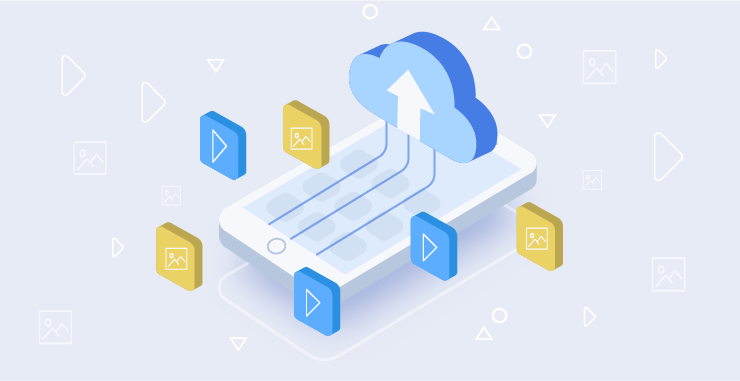

Did you remember those days when you have to upload a photo on a website? They used to show you a dumb GIF animation, indicating the progress of the file being uploaded. Nobody liked it but a workaround was impossible because there was no way around to upload and ping the server at the same time. ReactJS made it possible thanks to Async Await in React.
3. Real-time Chatting


You can build a real time chat app in React with Node, Socket.io and Express. Socket.IO is a JavaScript library and enables realtime, two-directional communication between web clients and servers. It has two parts: a client-side library that runs in the browser and can be integrated with React in a few lines of code. Then there is a server-side library for Node.js. Socket.IO is event-driven.While Socket.IO uses the WebSocket protocol, it has additional features like broadcasting to multiple sockets, storing data associated with each client, and asynchronous I/O.
Why Should You Develop Your Next Social Networking App in React?
ReactJS changed the dynamics of web development and raised the expectations of users from web app. They want the applications to look and feel like apps on their iPhones and Androids. Also, they want instant time and event based responses. Not to mention, social media applications are known for entertaining many users at a time. Did I mention scalability? Let’s take a look at why you should choose React.
- Rapid Development
If you have been using Facebook and Instagram, you know how often they bring new changes despite having a near monopoly. The demands of users are constantly evolving. The era of yearlong development cycles is long gone. If you can’t introduce a new version of app every month, you won’t stand a chance among your competitors. Therefore, rapid development is what you need with your social networking app goals.
Unidirectional data binding makes way for predictable application states which cuts chaos around web development. Developers tend to spend more time adding new features than figuring out the application. There is a reason so many developers are choosing React+Redux for build social networking applications
- Components, rather than Templates
I have been an advocate of HTML templates for a long time. Then React came around and now I find them intimidating to work with when developing single page features. Let’s say, on the fly, photo editing feature integrated into the application. With templates, we that features would be a nightmare to implement and you probably have to develop a custom web component to encompass the feature.
React use components so that you don’t have go through those bad dreams.
- Unparalleled Scalability
While this has more to do with the single-threaded, non-blocking architecture of Node, React and Node are match made in heaven. Theoretically, Node.js can partake infinite number of requests in its event loop without showing as sign of slowing down. Somebody said, social networking apps have to handle too many concurrent requests.
- Better User Experience
Since React and virtual-DOM free JavaScript development from the curse, your applications won’t be limited by extensive DOM manipulations. As a result, you applications would be much more responsive. Your users will relish this seamless user experience.
- Search Indexing
Your social network should have excellent presence on search engines such as Google and Bing. However, search engine spiders can’t render JavaScript yet and will return a blank page. You don’t want that to happen. Google, of course, will not index a page, which is blank to its crawler.
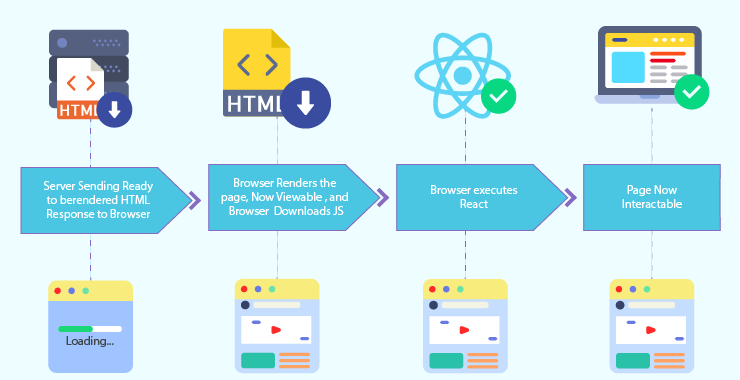

Lack of search engine optimization is a huge drawback of client side rendering. Not to worry though, ReactJS has first-class support for server-side rendering. Server-side rendering of JavaScript returns a pre-rendered HTML page for ready-display to the browser. The crawlers can crawl HTML as would any other web application. So next time your user search for their friend on Google, you page should be first on the list with their bio.
Hire React developers at TOPS to build your Social Networking App
Thousands of businesses around the world trust TOPS to take their JavaScript development efforts to the next. They hire React developers for their experience in Redux, JSX and ES6 and expertise in social networking apps.
- Experienced JS Developers
We have a team of expert JavaScript developers who have been writing React application for quite some time now and ready to take any challenge you will throw on them.
- State-of-the-art development center
Our offshore development is a subject of envy for our competitors. At TOPS, we believe imitation is the best form of flattery.
- Various Engagement Models
Our engagement models are as flexible as your project wants it to be. Talk to our engagement managers and they will show the best way of engagement.
Frequently Asked Questions
Why is React JS so popular?
React JS development is based on JavaScript, the world’s most popular language. It is simple to use, readily supported, and helpful for the rapid development of UI essentials. It has a virtual browser that helps developers to perform testing. It also uses a virtual DOM for quicker, lighter, high-performance apps, which enable it to be a popular choice for project planning phases.
Can React be added to an existing project?
As React is a library, it can indeed be used with an existing project. Once the set-up is done, add the React and DOM script tags to your existing HTML code. JavaScript file needs to be called, and a div tag needs to be placed with the components name as id.
Does React support gradual migration?
React is designed to make migration easy to adapt. You can utilize only the required features, and on the due course, you can add more React features to your codebase. Popular companies like Netlify have migrated from other JavaScript libraries/frameworks to React, phase-wise.
Which companies use React?
React is used by many famous companies like Facebook, Instagram, Netflix, Whatsapp, Khan Yahoo, Academy, Codecademy, Airbnb, Microsoft, Dropbox, Slack, Atlassian, Storybook, and much more.
Why Real-time Features are Important to Drive Mobile App Engagement?
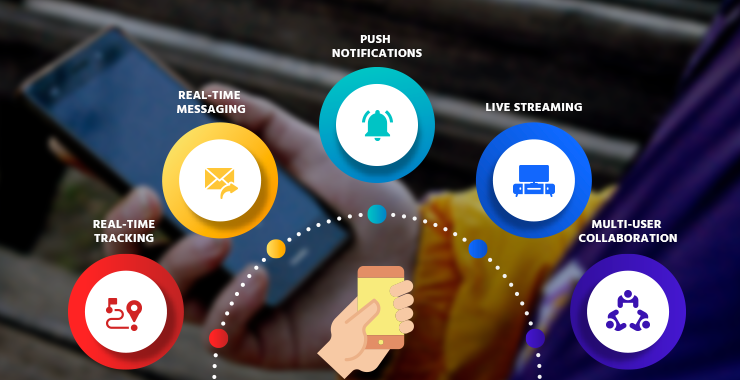

Technologies enabling real-time exchange of data bring new possibilities to what mobile applications can do. We are a generation obsessed with mobile gadgets and invest majority of our screen time interacting with apps on it. Some of your favorite applications such as instant messaging, online games, maps, and live video streaming dominate the world of app stores and the internet in terms of driving traffic.
In addition, several apps need to exchange data with application server in real-time to enable certain features. For example, on-demand taxi and delivery apps need real-time features to enable their users to track their cab and orders in real-life.
Tens of thousands of app on the app stores run some instance of real-time data exchange to run an app feature. Real-time features have a significant importance in mobile apps. To understand the significance in different types of apps; let’s explore what sort of real-time features they can enable in a mobile app and benefits they will bring.
1. Real-time Communication
Communication technology officially entered into an era of real-time communication with the invention of Telephone at Bell Labs. The introduction cellular phones brought us SMS and the internet brought us instant messengers (IMs) and voice calling. Capabilities communication apps of today bring would put even the most sophisticated communication device of yesteryears to shame. Today’s instant messaging apps such as WhatsApp and Facebook Messenger have every feature you need to communicate with someone. For starters, there is support for texting and multimedia messaging. Then there is location and document sharing in a conversational interface and of course, internet voice and video calling.
However, real-time communication has moved from being communication-centered apps only feature to a number of apps falling into diverse industries for example healthcare and on-demand delivery.
Rich Communication for Healthcare Apps
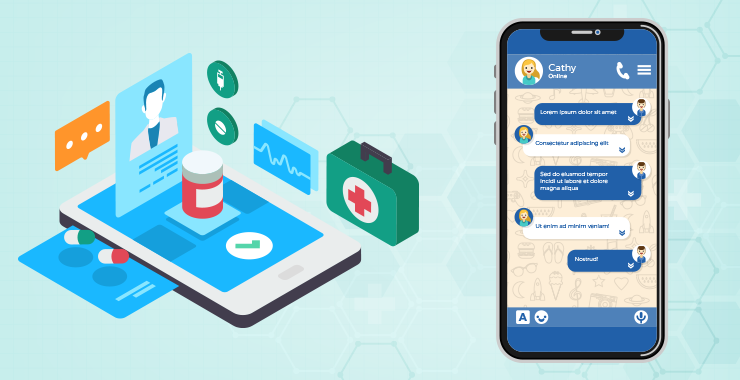

Around 80% of serious medical errors happen because of lack of communication between the caregivers and patients at the time of patient transfer, Joint Commission Center for Transforming Healthcare predicts.
Likewise, American International Group pinpoints poor culture, absence of collaboration; and lack of communication as the reasons putting patient well-being in hospital at stake.
By bringing the caregivers and patients on same app platform and connecting them over an integrated real-time communication channel, healthcare institutes and private practitioners can solve the gap between them and solve a fundamental problem engulfing healthcare industry.
A healthcare app with integrated chat features to enable communication between caregivers and patients bring the following benefits:
- Anytime passive communication for patients and caregivers
- Share reports and medical records as attachments
- Remote consultation with video calling
On-delivery Apps Need Real-time Messaging
On-demand apps have real-time messaging inbuilt to enable passengers communicate with the drivers in real-time and vice-a-versa. They can learn about each other’s whereabouts, talk about a delays if any, which vehicle they are carrying, etc. Active communication between the driver and passenger will avert disagreement and makes the flow of on-demand devices resourceful and welcoming.
Real-time Messaging and P2P eCommerce
Similar to on-demand delivery apps, in eCommerce apps, real-time messaging allows seamless flow of information, concerns and support from seller to buyer, which will avert third parties from taking cuts on every purchase and increase sellers’ profits per sale.
2. Multi-User Collaboration
With many workers opting to work from remote locations, employers are heavily invested into collaboration apps. Collaboration apps are the basis for virtual workspaces, where workers working on the same project can collaborate regardless of their location on a single workspace. Employers can grant access to multiple workspaces if the worker is involved in multiple projects simultaneously. The workspaces can be configured to allow continuous collaboration between employers and freelancers too. Multi-party collaboration features are a commonplace in various category of mobile apps.
Workspaces in Enterprise Mobility Solutions
With so many workplaces implementing BYOD policies, enterprise mobility has expanded over the years. One of the most important aspects of an enterprise mobility solution is to allow seamless collaboration between the employees while adhering to BYOD policies in place.
They need to create workspaces to allow real-time collaboration between employees and freelancers. However, freelancers aren’t bounded by BYOD policies while employees are. This creates quite a dilemma. If a freelancer deliberately or unconsciously breaks the policies, this will put the integrity of the whole environment in jeopardy in front of its employees and make them feel alienated.
Therefore, building workspaces in your enterprise mobility solution, which is already under the purview of BYOD policies, will put collaboration among freelancers and employees in the right direction.
Collaboration in Freelancers Marketplace
Many startups even enterprises rely on the pool of freelancers available from various marketplaces when they need additional resources at the earliest. While these marketplaces offer the greatest pool of talent, finding a freelancer perfect for the project at a reasonable rate isn’t simple at all. Freelancers tend to work on multiple projects at a time and often have too much on their plate. They may commit working 20 hours a week but may end up doing 9 hours in the week, which might put your project behind the deadline.
A real-time collaboration window between freelancers and customers will make way for transparency; wherein the customer can monitor the progress of the project and the hours logged. The customer can also leave a comment if he doesn’t like a module in the software system while the developer is writing test cases. So that the developer can make the changes at the very instant rather than making changes after he has merged the code to the main repository. Developers will also feel motivated if the customer is invested so much in the project.
3. Location Tracking
Smartphones have inbuilt location features which an app or service can share with someone you want over the internet. Operators in any variant of logistics operations such as food delivery, shipping, eCommerce, taxi hailing, etc. need to keep a tab on their assets, humans or things. For example, when you order food from a food delivery app, you want to learn how far the order has reached. The same goes for when you request an Uber.
![]()
![]()
Location Tracking for Users
When you order pizza on Dominoes or a cab on Uber, you tend to learn how far the driver or pizza boy is from your place; if they are on the wrong lane, stuck in a traffic jam. The app needs your location to give you estimated time of arrival and drop-off location to the customer.
Location tracking allows the whole model around on-demand delivery to work together.
Location Tracking for Operators
Live tracking allows operators at shipping companies to track their assets in real-time on an ever-accessible web application. Mobile apps can call the same API to act as a location-tracking device. Transportation companies need to track not just a couple of drivers but their entire fleet, which may be scattered across the globe.
In addition, on-demand operators and underlying software need to know location of its drivers and customers to bring the connection and allow for seamless passing of location information between the two.
4. Live Streaming
Businesses and individuals love live streaming apps alike. In numerous business sectors from media to logistics and entertainment to real estate, live data streaming apps have allowed business to bring the action closer to their customers. The ability of such apps to simultaneously capture, process, and transmit data to millions of other users brings many benefits.


Live Streaming Features in Social Media Apps
Live data streaming is a foundational element for livestreaming, allowing social media influencers to showcase their favorite products, gamers to stream the latest games, and businesses to host live events—all through social media apps integrated with livestreaming features. Video streaming has become an essential social media feature in app development.
Twitter acquired Periscope because it helped bring live video streaming into the mainstream. Today, three of the most popular mobile apps—Facebook, YouTube, and Instagram—have live streaming features built-in. Facebook Live, in particular, is experiencing significant growth, with four times the number of viewers for its live feeds compared to a year ago.
Live Streaming of Data for Trading Apps
Commodity and stock markets are always changing. People trading on them need the most up-to-date information to make buying and selling decision. Trading in 21st century revolves around computer screens rather than phones or shouting in Wall Street to buy and sell securities. Today, a large number of people rely on their phones to get a glimpse of the stock market, indices and how’s the security they are invested in doing. Trading platforms have grew in number with so many people looking at stock market to make quick bucks and a lot of them are bringing trading to intimate device we have—our smartphone.
Real-time data exchange allows apps to display up-to-date stock prices, making them excellent platforms to run trading apps. Also, a real-time messaging feature will facilitate communication between broker and trader.
5. Push Notification
The major reason to run real-time notifications is to generate a sense of urgency among the customers. Every sort of mobile apps employ push notification in a unique way. Real-time notifications are major reasons for the success mobile as a platform of marketing. However, a few apps are employing push notification to trigger user actions.
Role of Push Notification in On-demand Apps
In addition, real-time notifications pay crucial part in the functioning of an on-demand app. In fact, on-demand apps can work without the provision of live notifications. Push notifications play an active part to alert the driver whenever a passenger requests a cab. The nearest driver receives the ride request in as a real-time notification with the option to accept or decline the offer.
Push Notification in Retail Apps
eCommerce apps rely too much on push notifications for everything from notifying their customer of their order dispatch or a flash sales. Real-time notification helps delivery persons to arrive at the pick-up location on time and therefore; a number of eCommerce apps employ push notification as a tool to boost their sales number.
Online marketplaces tend classify their users as per their purchase behavior. A frequent buyer will fall in a smaller bucket than a high-value buyer but larger than one-time buyer. They target them with live notifications by throwing marketing offers according to their bucket size and past purchases. For example, you are most likely to hear from the eCommerce app installed in your phone when JRR Martin will release Winds of Winter.
eCommerce marketplaces are infamous for reducing brand value by offering premium brands at dirt-cheap rate. Customers don’t mind discounts and if you think the discounted price will entice them, what is the harm in throwing them the offer in a real-time push notification. The click might lead to conversion.
Integrating real-time features in your mobile app
TOPS has an immense experience in building real-time applications as well as integrating real-time features in existing mobile apps. One of the mobile applications we developed as ‘marketplace for freelancers’ was struggling with user retention; we ran a thorough analysis and found they don’t have a place to communicate in real-life on the app. We integrated chat feature in the app and could pause users from leaving the app. Mobile apps benefit from real-time features in terms of user engagement, quick exchange of information, and data validity.




